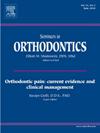数字MARPE在正畸学中的临床应用和结果:范围综述
IF 2
4区 医学
Q2 DENTISTRY, ORAL SURGERY & MEDICINE
引用次数: 0
摘要
目的:本综述旨在评估关于数字微型辅助快速腭扩张器(MARPE)应用的文献,强调计划、设计和制造过程中的技术进步、临床结果以及将数字技术集成到MARPE工作流程中所提供的潜在优势。marpe是一种广泛使用的技术来解决上颌骨骼缺陷,特别是在成人和青少年晚期患者。无论使用传统方法还是数字方法,MARPE的核心功能都保持一致。然而,像CAD-CAM和CBCT这样的数字技术已经引入了新的方法来提高MARPE治疗的精度和定制化。方法遵循PRISMA-ScR指南,在PubMed、Scopus、Web of Science和b谷歌Scholar等数据库中进行全面的文献检索。使用的搜索词包括“数字MARPE”,“微型辅助快速腭扩张器”和“数字正畸器具”。纳入标准侧重于将数字技术纳入MARPE的设计、规划或制造阶段的研究。仅描述传统MARPE的研究或非英语文章被排除在外。结果共纳入文献1024篇,经纳入标准和全文筛选,最终纳入12篇。正如所回顾的研究所证明的那样,CAD-CAM等数字技术的集成大大提高了MARPE治疗的精度、定制性和可预测性。数字工作流程使正畸医生能够精确地将MARPE设备与患者的解剖结构对齐,最大限度地减少并发症并提高治疗效率。cad - cam支持的MARPE装置能够产生有效的中腭缝分离和骨骼扩张,即使在腭骨厚度小于传统扩张方法的最佳情况下。我们观察到,3d打印结合CBCT可以帮助克服预制MARPE设计的局限性,预制MARPE设计可能并不总是适合高弓腭的病例,从而影响锚固。结论数字技术在MARPE治疗中的应用在精确性、定制化和工作流程效率方面具有明显的程序优势。然而,无论采用数字方法还是传统方法,MARPE的基本临床疗效是一致的。未来的研究应侧重于定量评估数字化工作流程对治疗结果、患者舒适度和程序效率的长期影响。本文章由计算机程序翻译,如有差异,请以英文原文为准。
The clinical applications and outcomes of digital MARPE in orthodontics: A scoping review
Aim
This scoping review aims to assess the literature on the use of digital Miniscrew-Assisted Rapid Palatal Expander (MARPE) appliances, highlighting the technological advancements in the planning, design, and manufacturing process, the clinical outcomes, and potential advantages offered by integrating digital technology into the MARPE workflow.
Background
MARPE is a widely used technique to address maxillary skeletal deficiencies, particularly in adult and late adolescent patients. The core function of MARPE remains consistent regardless of whether conventional or digital approaches are used. However, digital technologies like CAD-CAM and CBCT have introduced new methods for improving precision and customization in MARPE treatments.
Methodology
The PRISMA-ScR guidelines were followed, conducting a comprehensive literature search across databases such as PubMed, Scopus, Web of Science, and Google Scholar. The search terms used included “digital MARPE,” “miniscrew-assisted rapid palatal expander,” and “digital orthodontic appliances.” Inclusion criteria focused on studies incorporating digital technologies in the design, planning, or manufacturing stages of MARPE. Studies only describing the conventional MARPE, or non-English articles were excluded.
Results
A total of 1,024 publications were identified and after applying the inclusion criteria and full-text screening,12 articles were included in the final analysis. It was observed that the integration of digital technologies, such as CAD-CAM, has dramatically enhanced the precision, customization, and predictability of MARPE treatments, as evidenced in the studies reviewed. Digital workflows enable orthodontists to precisely align MARPE devices with the patient's anatomy, minimizing complications and enhancing treatment efficiency. CAD-CAM-enabled MARPE devices were able to produce effective mid-palatal suture separation and skeletal expansion even in situations where the thickness of the palatal bone was less than optimum for conventional expansion methods. It was observed that 3D-printing combined with CBCT could help overcome the limitations of prefabricated MARPE designs, which may not always fit well in cases with high-arched palates, thus compromising anchorage.
Conclusion
The introduction of digital technologies in MARPE treatments has offered clear procedural advantages in terms of precision, customization, and workflow efficiency. However, the fundamental clinical efficacy of MARPE remains consistent, regardless of whether digital or conventional methods are used. Future research should focus on quantitatively assessing the long-term impact of digital workflows on treatment outcomes, patient comfort, and procedural efficiency.
求助全文
通过发布文献求助,成功后即可免费获取论文全文。
去求助
来源期刊

Seminars in Orthodontics
DENTISTRY, ORAL SURGERY & MEDICINE-
CiteScore
2.20
自引率
4.80%
发文量
28
审稿时长
10 days
期刊介绍:
Each issue provides up-to-date, state-of-the-art information on a single topic in orthodontics. Readers are kept abreast of the latest innovations, research findings, clinical applications and clinical methods. Collection of the issues will provide invaluable reference material for present and future review.
 求助内容:
求助内容: 应助结果提醒方式:
应助结果提醒方式:


